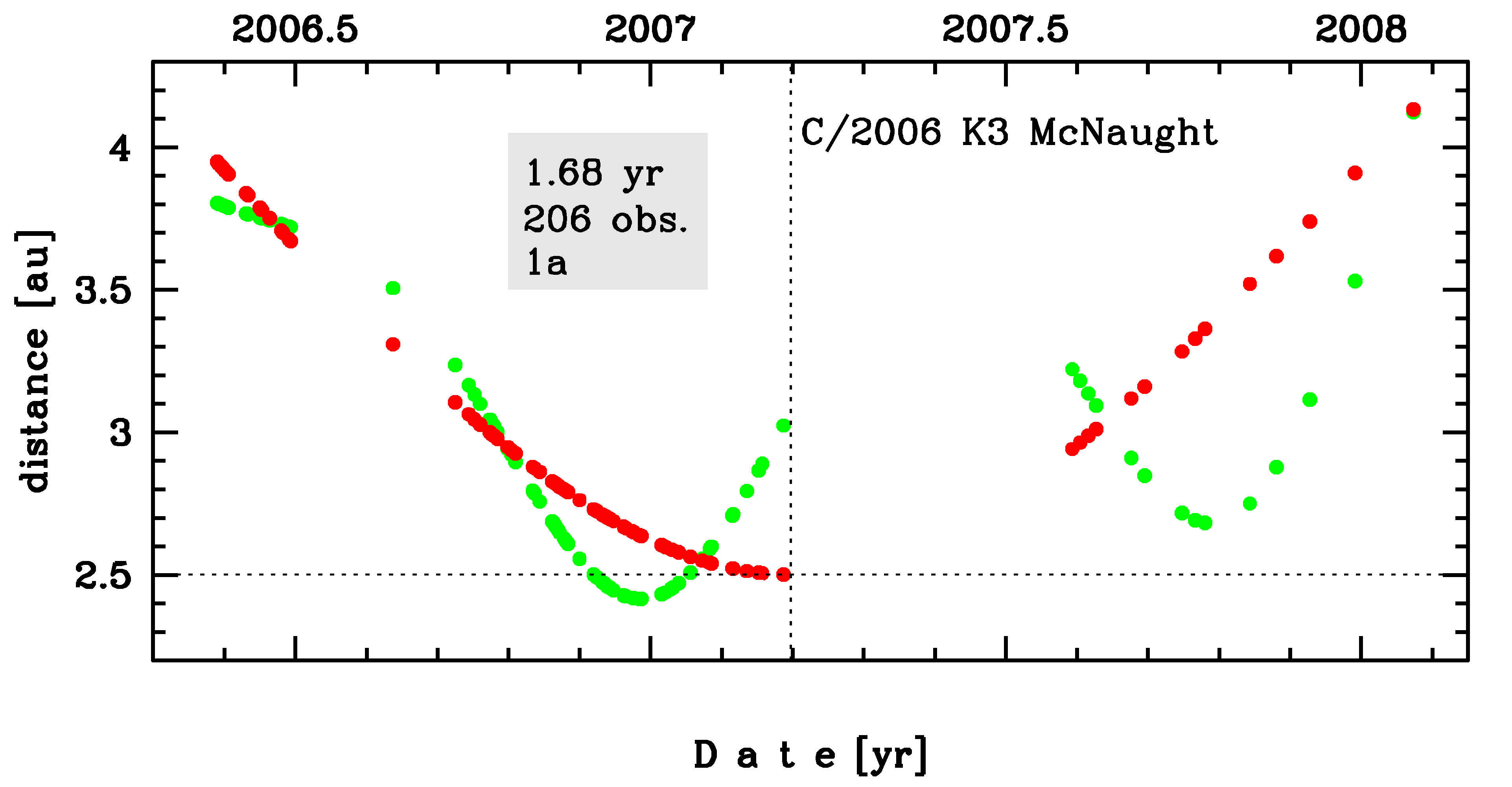C/2006 K3 McNaught
more info
Comet C/2006 K3 was discovered on 22 May 2006 by Robert H. McNaught (Siding Spring Survey), that is about almost 10 months before its perihelion passage. It was observed until 26 January 2008.
Comet had its closest approach to the Earth on 26 December 2006 (2.416 au), about 2.5 months before its perihelion passage.
Solutions given here are based on data spanning over 1.68 yr in a range of heliocentric distances: 3.95 au – 2.501 au (perihelion) – 4.13 au.
This Oort spike comet suffers small planetary perturbations during its passage through the planetary system; however, these perturbations lead to escape the comet from the planetary zone on a hyperbolic orbit (see future barycentric orbits).
See also Królikowska and Dybczyński 2013 and Królikowska 2020.
Comet had its closest approach to the Earth on 26 December 2006 (2.416 au), about 2.5 months before its perihelion passage.
Solutions given here are based on data spanning over 1.68 yr in a range of heliocentric distances: 3.95 au – 2.501 au (perihelion) – 4.13 au.
This Oort spike comet suffers small planetary perturbations during its passage through the planetary system; however, these perturbations lead to escape the comet from the planetary zone on a hyperbolic orbit (see future barycentric orbits).
See also Królikowska and Dybczyński 2013 and Królikowska 2020.
| solution description | ||
|---|---|---|
| number of observations | 206 | |
| data interval | 2006 05 22 – 2008 01 26 | |
| data type | significantly more measurements before perihelion (PRE+) | |
| data arc selection | entire data set (STD) | |
| range of heliocentric distances | 3.95 au – 2.50 au (perihelion) – 4.13 au | |
| type of model of motion | NS - non-gravitational orbits for standard g(r) | |
| data weighting | YES | |
| number of residuals | 402 | |
| RMS [arcseconds] | 0.54 | |
| orbit quality class | 1a | |
| previous orbit statistics, both Galactic and stellar perturbations were taken into account | ||
|---|---|---|
| no. of returning VCs in the swarm | 5001 | * |
| no. of escaping VCs in the swarm | 0 | |
| no. of hyperbolas among escaping VCs in the swarm | 0 | |
| previous reciprocal semi-major axis [10-6 au-1] | 56.64 – 61.74 – 67.82 | |
| previous perihelion distance [au] | 2.55 – 2.69 – 2.91 | |
| previous aphelion distance [103 au] | 29.5 – 32.4 – 35.3 | |
| time interval to previous perihelion [Myr] | 1.8 – 2.1 – 2.4 | |
| percentage of VCs with qprev < 10 | 96 | |
| percentage of VCs with 10 < qprev < 20 | 2 | |
| percentage of VCs with qprev > 20 | 2 | |
| previous_g orbit statistics, here only the Galactic tide has been included | ||
|---|---|---|
| no. of returning VCs in the swarm | 5001 | * |
| no. of escaping VCs in the swarm | 0 | |
| no. of hyperbolas among escaping VCs in the swarm | 0 | |
| previous reciprocal semi-major axis [10-6 au-1] | 55.22 – 61.10 – 67.09 | |
| previous perihelion distance [au] | 2.328 – 2.339 – 2.431 | |
| previous aphelion distance [103 au] | 29.8 – 32.7 – 36.2 | |
| time interval to previous perihelion [Myr] | 1.8 – 2.1 – 2.4 | |
| percentage of VCs with qprev < 10 | 100 | |
